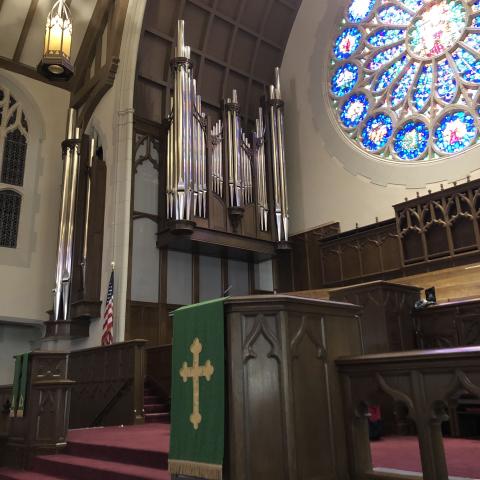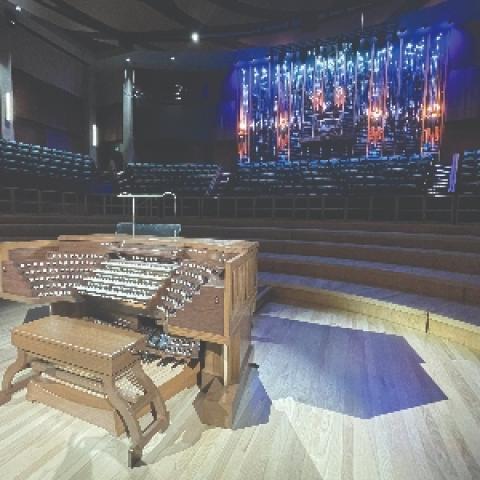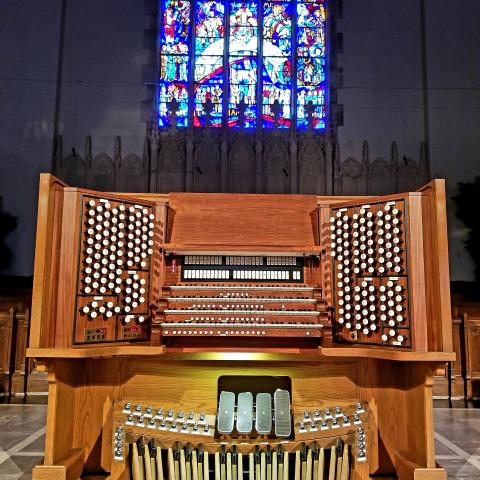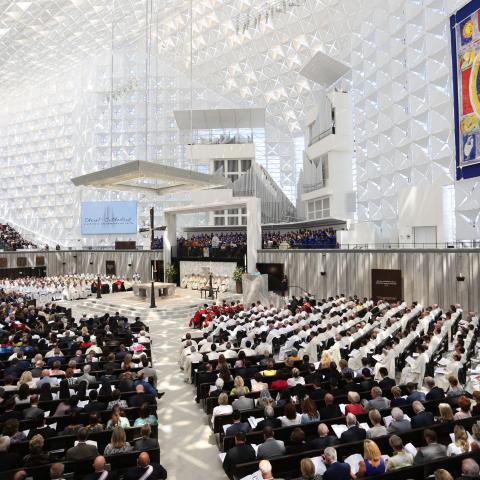Orgues Létourneau, St-Hyacinthe, Québec, Canada; Market Square Presbyterian Church, Harrisburg, Pennsylvania
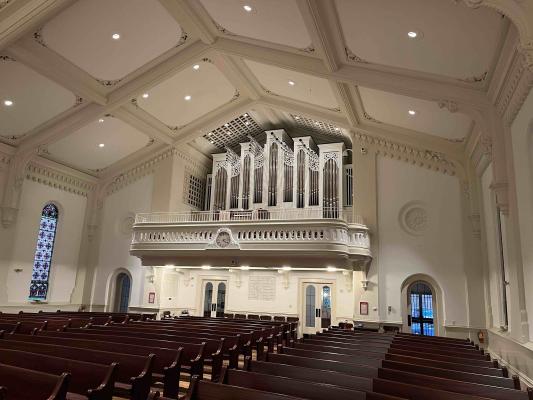
From the builder
Market Square Presbyterian Church has long been a landmark in Pennsylvania’s capital city. The congregation was founded in 1794 and has occupied its current sanctuary since 1860. The church today is simultaneously traditional and modern, with worship services that balance thought-provoking sermons and inspiring music. Market Square Church also puts an emphasis on service, with ministries to support homeless and transient persons in downtown Harrisburg, as well as refugees and immigrants. The congregation is actively involved in a variety of social justice endeavors, supports environmental initiatives, provides hospitality to local groups, and offers a broad embrace to the LGBTQ+ community. It has been our experience that all are admirably welcome at Market Square Church.
Our first of many visits to Market Square Church was at the invitation of the church’s new minister of music, the tireless Tyler Canonico. Our broad mandate was to survey the church’s pipe organ and to present options on what could be done.
M. P. Möller’s Opus 11805 of three manuals and 83 ranks was completed in 1991, incorporating much of the church’s previous Aeolian-Skinner pipe organ from 1947 (Opus 1048). The Aeolian-Skinner had been hidden within chambers, but the Möller displayed zinc and spotted metal façade pipes in a case housing its Grand Orgue division across the back of the loft. A new Positif division was divided between two cases on the gallery rail. The organ additionally had two sizable and independently expressive Récit divisions in opposing chambers; both Récits played awkwardly from the upper manual at the console.
During that first visit, we concluded a top-to-bottom reconstruction of the organ was needed. In addition to desirable tonal improvements, the three-manual console was worn beyond redemption, and the instrument’s switching system was obsolete. The crude casework needed to be replaced with something more appropriate, but more pressing, the two organ chambers’ flimsy hardboard walls and ceilings required substantial improvement.
Our subsequent proposal recommended reusing the Möller and Aeolian-Skinner materials where possible as a measure of good stewardship. This included most of the pipework, the electro-pneumatic windchests, and some wind reservoirs. From a tonal perspective, we wanted to consolidate the instrument within the limits of what the windchests could accommodate. While a new Great and part of the Pedal would reside in a central organ case, the Möller’s Récit divisions could be brought together into a proper Swell in the east chamber. A tertiary Choir division would offer complementary colors in the west chamber, and through refashioning one of the Aeolian-Skinner windchests, a new ten-rank String division could reside under the Choir division. A small Positive division would reuse one of the chests previously on the gallery rail but would sit in front of the Choir behind the loft’s west ceiling grille.
The project we proposed was significant but at no time did we get the sense that our far-reaching ideas were unsettling to the organ study committee. The committee seemed ready for a challenge, as did the broader church in later meetings. Indeed, our discussions about renewing the pipe organ grew into a broader review of the church’s sanctuary and its acoustic, as well as the organ loft and the limitations it presented for the choir. Acoustician Dan Clayton soon joined the team, ensuring the acoustic would be improved for music without harming the spoken word. This global project at Market Square Church was spearheaded by David and Gwen Lehman over a two-year period. Their assiduous work resulted in new hardwood flooring for the sanctuary, comfortable new pews, a reconfigured choir loft, and refurbished organ chambers. Throughout the project, the organ study committee’s and the Lehmans’ efforts were supported time and time again by the church’s director of music emerita, Ellen Hunt, and the church’s senior pastor, the Reverend Tom Sweet.
The Möller pipe organ was removed and packed for shipment to our workshops in January 2020 by a team from Létourneau, along with John Carmichael of Patrick J. Murphy & Associates. Once in our workshop, our pipe makers took a complete inventory of the Möller and Aeolian-Skinner pipework, making repairs as necessary. Fellow organbuilder Randall Dyer had also helpfully provided valuable scaling information and related documentation on Opus 11805 from his M. P. Möller archive.
Several stops were rescaled as part of the project, including the Great 8′ Harmonic Flute, the Great five-rank Cornet, the Swell 8′ Viole de gambe, and the Swell 8′ Voix Celeste to better obtain these stops’ characteristic colors. Other ranks were repurposed: a Möller 8′ Flûte céleste rank now serves as the Pedal 51⁄3′ Quint while the 13⁄5′ Tierce from the Möller Positif is now the Pedal 2′ Open Flute with the addition of new bass pipes. Of the new organ’s 83 ranks, some 21 ranks came from Aeolian-Skinner’s Boston workshops and another 46 ranks were made in Hagerstown, with the final 16 ranks having been built in St-Hyacinthe.
The Aeolian-Skinner and Möller electro-pneumatic windchests were restored to like-new condition in our workshops, with new unit chests built as needed. Designed by Claude Demers, the new organ case was built by our cabinetmakers from solid maple with walnut accents. The façade displays tin pipework from the Great 8′ Open Diapason, the Pedal 8′ Principal, and most prominently, the 8′ Trompette en chamade. The pipe shades were designed in a greatly simplified Gothic style and were machined on our CNC machine.
One of the project’s surprises occurred while examining the bass of the Pedal 16′ Contrabass in our woodshop. These twelve pipes were built in pine by Aeolian-Skinner to a lean scale and voiced with large beards. Without an organ built around them, their full length was revealed to show the pipe bodies were not quite true. The pipes had been deliberately built with “bellies,” meaning the middle of the pipe body is fractionally larger than the ends. Seen more frequently in metal string pipes, the theory is the bellied construction encourages prompt speech. This discovery presented an opportunity to document these pipes and how they were constructed.
The new organ—Létourneau’s Opus 136—made its way to Harrisburg in the spring of 2021, with the installation by our team continuing into the summer. The onsite flue voicing was fully underway by September, and the work was painstakingly executed by Samantha Koch and Christopher Bono, with help at various points from Megan Farrell (of Patrick J. Murphy & Associates) and John Johnson. The final phase of the voicing, Opus 136’s twelve ranks of reeds were voiced by Michel Godbout. The voicing process was assisted by a remote keyboard placed in the center of the sanctuary’s third pew. Connected wirelessly to the Solid State Organ Systems’ switching network, the keyboard allowed us to carefully evaluate sounds from another reference point beyond the console, usefully confirming or correcting voicing decisions made from the loft.
Though completed in late October 2021, Opus 136’s first solo concert took place on February 25, 2022, with virtuoso Ken Cowan at the console. In response to works by Widor, Litaize, and Bach—as well as transcriptions of works by Saint-Saëns and Wagner—the capacity crowd’s responses were nothing short of ecstatic. Mr. Cowan also brilliantly introduced a work commissioned for the evening, the Michelangelo Fantasy by Dr. Scott H. Eggert.
— Orgues Létourneau
From the minister of music
Blessed by but not captive to a rich history, Market Square Presbyterian Church continues to serve its congregants and its community through worship and music. The major renovations of our pipe organ and sanctuary reaffirm our congregation’s commitment to the present and future of this church as a beacon of hope on the square.
When I interviewed for the post of minister of music, the Rev. Thomas Sweet told me of the church’s need to launch an organ project. After my arrival in July 2017, I soon found myself presenting to various committees the many failings of the church’s M. P. Möller organ. Co-chaired by Ellen Hunt (minister of music emerita) and me, our organ study committee interviewed several organbuilders, and we concluded that Létourneau was the best company for our project. After working with Létourneau to refine their proposal, the contract for the instrument was unanimously approved by the church’s board of trustees and session in January of 2018.
Létourneau Opus 136 reuses the best of the Aeolian-Skinner and Möller pipework to reorient the organ towards accompanying duties, leading hymn singing, and the performance of solo repertoire. Each stop was reworked and revoiced by Létourneau for remarkably cohesive choruses while assuring each stop’s musicality. On Létourneau’s recommendation, Market Square Church rebuilt the organ chambers with harder, denser surfaces to better reflect sound. Now, the full spectrum from the organ’s expressive divisions is projected into the sanctuary, especially in the bass and middle registers. With the old Positif cases removed from the loft rail, the rail itself was reconstructed to resemble the original from 1860, with minor differences to accommodate acoustical considerations and building codes.
The sanctuary renovation was occasioned by a desire to improve its acoustic for choral singing, hymnody, and the pipe organ while preserving the fine acoustic for the spoken word. This was achieved by installing a hardwood floor, with minimal carpeting in the aisles. The church took advantage of this opportunity to refresh the sanctuary with a new color scheme for the walls and ceiling, new pews with acoustically neutral cushions, and a new sound system.
Market Square Church has, from its earliest days, been located in the heart of Harrisburg, and it serves its members’ needs as well as those of the surrounding community. The church’s music ministry has been integral in this effort as a means of making God, beauty, and our shared humanity accessible to everyone, member or not. Generously underwritten by the Nedra J. Schilling Foundation, the organ project was conceived and approved under this principle as a gift to members and the community at large, now and for the future.
The members of Market Square Church as well as Harrisburg’s broader musical community have been delighted as we continue to explore the capabilities of our Létourneau pipe organ. I remain thankful to all who gave generously—especially during the pandemic—and I am grateful to the amazing team at Létourneau who delivered such an astonishing musical instrument!
—Tyler A. Canonico, Minister of Music
GREAT – Manual II – 95 mm pressure
16′ Violoncello 12 pipes extension of 8′ Violoncello
8′ Open Diapason 61 pipes new, 70% tin
8′ Harmonic Flute 61 pipes Möller and new pipework
8′ Violoncello 61 pipes Möller pipework
8′ Chimney Flute 61 pipes 1–12 Möller, 13–61 Aeolian-Skinner pipework
4′ Principal 61 pipes Möller pipework
4′ Open Flute 61 pipes Möller pipework
2′ Fifteenth 61 pipes Möller pipework
2′ Mixture V 305 pipes Möller and new pipework
1′ Sharp Mixture IV 244 pipes Möller and new pipework
8′ Grand Cornet V 220 pipes c13 through g56, rescaled Möller pipework
16′ Double Trumpet 61 pipes 1–12 Möller, 13–61 Aeolian-Skinner pipework
8′ Trumpet 61 pipes Möller pipework
4′ Clarion 61 pipes Möller pipework
Great 16′
Great Unison Off
Great 4′
8′ Trompette en chamade 66 pipes new, 70% tin (140 mm pressure)
Zimbelstern I 6 bells
Zimbelstern II 8 bells
Nachtigal
Chimes from Choir
SWELL (enclosed) – Manual III – 125 mm pressure
8′ Open Diapason 61 pipes Aeolian-Skinner pipework
8′ Flûte traversière 61 pipes Aeolian-Skinner pipework
8′ Viole de gambe 61 pipes rescaled Möller pipework
8′ Voix Celeste 61 pipes rescaled Möller pipework with new bass
8′ Lieblich Gedackt 61 pipes Möller pipework
4′ Principal 61 pipes Aeolian-Skinner pipework
4′ Flûte octaviante 61 pipes Möller pipework
2′ Octavin 61 pipes Möller pipework
2′ Mixture III–V 259 pipes Möller pipework with new
16′ Fagotto 61 pipes 1–24 Aeolian-Skinner, 25–61 Möller pipework
8′ Trumpet 66 pipes new, 56% tin
8′ Oboe 61 pipes Aeolian-Skinner pipework
8′ Vox Humana 61 pipes Aeolian-Skinner pipework
4′ Clarion 78 pipes new, 56% tin
Tremulant
Swell 16′
Swell Unison Off
Swell 4′
16′ Trompette en chamade (TC) from Great
8′ Trompette en chamade from Great
STRING (enclosed) – floating – 285 mm pressure
16′ Contre Viole 61 pipes new, zinc and 56% tin
8′ Viole d’orchestre 61 pipes new, zinc and 56% tin
8′ Viole Celeste 61 pipes new, zinc and 56% tin
8′ Dulciana 61 pipes Aeolian-Skinner pipework
8′ Unda maris 61 pipes Aeolian-Skinner pipework
4′ Viole octaviante 61 pipes new, zinc and 56% tin
4′ Dulcet 61 pipes new, zinc and 56% tin
31⁄5′ Chœur des violes III 183 pipes new, 56% tin
Tremulant
Echo Chimes from Positive
Harp from Choir
CHOIR (enclosed) – Manual I – 110 mm pressure
16′ Bourdon 12 pipes extension of 8′ Bourdon (Möller pipework)
8′ Geigen Diapason 61 pipes Möller pipework
8′ Bourdon 61 pipes Aeolian-Skinner pipework
4′ Gemshorn 61 pipes Möller pipework
2-2⁄3′ Nazard 61 pipes Möller pipework
2′ Flageolet 61 pipes Möller pipework
1-3⁄5′ Tierce 61 pipes Möller pipework
8′ Clarinet 61 pipes Möller pipework
Tremulant
8′ Tuba 61 pipes Möller pipework (350 mm pressure)
Choir 16′
Choir Unison Off
Choir 4′
8′ Trompette en chamade from Great
Chimes digital Walker Technical Co.
Harp digital Walker Technical Co.
Glockenspiel digital Walker Technical Co.
POSITIVE – Manual IV – 85 mm pressure
8′ Stopped Diapason 61 pipes Möller pipework
4′ Koppelflöte 61 pipes Möller pipework
2′ Fifteenth 61 pipes Möller pipework
1-1⁄3′ Larigot 61 pipes Möller pipework
1-1⁄3′ Tierce Mixture V 305 pipes Möller and new pipework
8′ Cremona 61 pipes new, 56% tin
Tremulant
Positive 16′
Positive Unison Off
Positive 4′
16′ Tuba (TC) from Choir
8′ Tuba from Choir
16′ Trompette en chamade (TC) from Great
8′ Trompette en chamade from Great
Echo Chimes digital Walker Technical Co.
Glockenspiel from Choir
PEDAL – 142 mm and 120 mm pressure
32′ Contra Geigen digital Walker Technical Co.
32′ Contra Bourdon digital Walker Technical Co.
16′ Contrabass 32 pipes 1–12 Aeolian-Skinner, 13–32 Möller pipework
16′ Violoncello from Great
16′ Subbass 32 pipes Aeolian-Skinner pipework
16′ Viole d’orchestre from String
16′ Bourdon from Choir
8′ Principal 32 pipes new, 70% tin
8′ Spitzflöte 32 pipes Aeolian-Skinner pipework
8′ Violoncello from Great
8′ Bourdon from Choir
5-1⁄3′ Quint 32 pipes Möller pipework
4′ Choral Bass 32 pipes rescaled Möller pipework
4′ Spitzflöte 12 pipes extension of 8′ Spitzflöte
2′ Open Flute 32 pipes rescaled Möller pipework
2-2⁄3′ Mixture IV 128 pipes Möller pipework
32′ Contra Bombarde digital Walker Technical Co.
32′ Contra Fagotto 12 pipes extension of Swell 16′ Fagotto
16′ Bombarde 32 pipes Aeolian-Skinner pipework (150 mm w.p.)
16′ Fagotto from Swell
8′ Bombarde 12 pipes extension of 16′ Bombarde
4′ Bombarde 12 pipes extension of 8′ Bombarde
8′ Tuba from Choir
8′ Trompette en chamade from Great
Chimes from Choir
Echo Chimes from Positive
Orage Walker Technical Co.
Intermanual Couplers
Great to Pedal Great 4′ to Pedal
Swell to Pedal Swell 4′ to Pedal
Choir to Pedal Choir 4′ to Pedal
Positive to Pedal Positive 4′ to Pedal
String to Pedal String 4′ to Pedal
Swell 16′ to Great Swell to Great Swell 4′ to Great
Choir 16′ to Great Choir to Great Choir 4′ to Great
Positive 16′ to Great Positive to Great Positive 4′ to Great
String 16′ to Great String to Great String 4′ to Great
Swell 16′ to Choir Swell to Choir Swell 4′ to Choir
Positive 16′ to Choir Positive to Choir Positive 4′ to Choir
String 16′ to Choir String to Choir String 4′ to Choir
String 16′ to Swell String to Swell String 4′ to Swell
Positive 16′ to Swell Positive to Swell Positive 4′ to Swell
Choir to Swell
Great to Positive
Swell to Positive
Choir to Positive
String to Positive
Mixture Compositions
Great Mixture V
c1 to b12 15 19 22 26 29
c13 to b24 12 15 19 22 26
c25 to b36 8 12 15 19 22
c37 to g44 1 8 12 15 19
g#44 to c61 1 5 8 12 15
Great Sharp Mixture IV
c1 to b12 22 26 29 33
c13 to a22 19 22 26 29
a#23 to g#33 15 19 22 26
a34 to f42 12 15 19 22
f#43 to d#52 8 12 15 19
e53 to c61 1 8 12 15
Swell Mixture III–IV
c1 to e17 15 19 22
f18 to e29 12 15 19 22
f30 to e41 8 12 15 19 22
f42 to c49 1 8 12 15 19
c#50 to c61 1 5 8 12 15
Positive Tierce Mixture V
c1 to c#14 19 22 24 26 29
d15 to e29 15 19 22 24 26
f30 to g44 12 15 17 19 22
g#44 to d51 8 12 15 17 19
d#52 to c61 1 8 10 12 15
String Choeur des violes III
c1 to c49 10 12 15
c#50 to f54 8 10 12
f#55 to g#57 5 8 10
a58 to c61 3 5 8
Pedal Mixture IV
c1 to g32 19 22 26 29
83 total stops, 83 ranks, 4,683 pipes
Builder’s website: www.letourneauorgans.com
Church’s website: www.marketsquarechurch.org
Photo credits:
Cover and page 22: Ollie Silver
Trompette-en-chamade and console: Don Giles
Remaining photos: Orgues Létourneau

